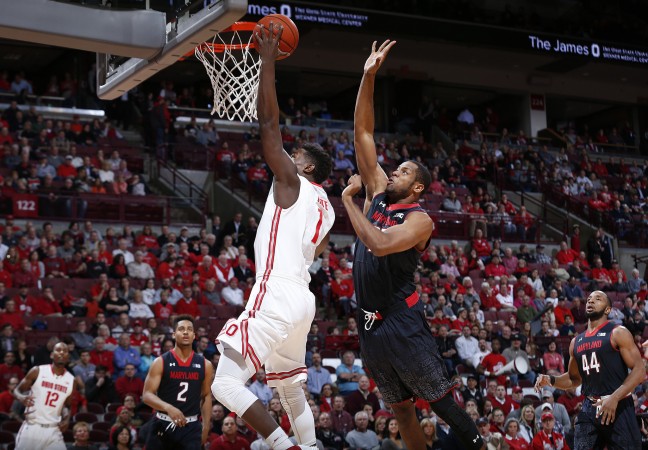Remember the end of last March?
Heading into the Elite Eight’s four regional finals, three Big Ten basketball teams had a chance to go to the Final Four. Two teams were seeded higher than their opponents (Michigan versus Kentucky in the Midwest, Michigan State versus Connecticut in the East), and the third team was arguably the best in the league, certainly no worse than second (Wisconsin).
Michigan State was unlucky in that Connecticut enjoyed a virtual home game in Madison Square Garden in New York. Had that game been outside the Northeast — a South Regional final or a West Regional final — the Spartans would have loved their chances. At any rate, they fell short, but their win over top-seeded Virginia in the Sweet 16 gave their season a substantial boost. Michigan State showed what it could do, even though it didn’t quite reach college basketball’s holy grail.
For Michigan, the story was similar. The Wolverines engaged Kentucky in a high-level regional final, but the Wildcats’ shotmaking was just a little bit better — no regrets.
Then came Wisconsin, a team good enough to take down Arizona by an eyelash in the final seconds. The Badgers finally got Bo Ryan to a Final Four, and the Big Ten wasn’t shut out of Arlington. With three Elite Eight teams last season, the conference had a lot to be proud of in basketball. Moreover, with Wisconsin looking every bit the part of a Final Four team this year, the Big Ten knows it has a horse it can ride.
So, why is the conference in such bad shape as January comes to a close?
*
Thursday night, Maryland — a new member of the conference — suffered a second straight Thursday night road loss, a blowout just as bad as a Jan. 22 visit to Indiana. A week ago, the Terrapins lost to the Hoosiers, 89-70. On Jan. 29, Maryland got run out of another Big Ten building, as Ohio State trounced the Turtles, 80-56. Maryland shot under 31 percent against the Buckeyes and allowed OSU to rebound 50 percent of its misses (16 of 32). Nothing went right for Maryland, and as a result, Wisconsin is now the only Big Ten team with fewer than four losses.
A look at the Big Ten reveals a conference that is a shell of what it was — not five years ago or even three years ago, but just a single year ago. Last year, the league’s three Elite Eight teams (Wisconsin, Michigan, and Michigan State) were all protected seeds (4 or higher). The league didn’t just get teams into the tournament; it produced highly-seeded teams. If you shift to the current season, the outlook isn’t as rosy.
Yes, it’s true that Maryland is still enjoying a bounce-back season under head coach Mark Turgeon, whose preseason hot seat is now cold and comfortable. The Terps are very likely going back to the NCAA tournament, restoring a bit of their reputation after several bumpy seasons. None of what’s being said here should detract from what Maryland is achieving on the court. Yet, Maryland and the team it lost to on Thursday, Ohio State, are tied for second in the Big Ten.
If the league got three protected seeds last year, it might be looking at only one protected seed in 2015. Either Maryland or Ohio State would have to produce a nearly flawless February and get some work done in the Big Ten tournament in order for the conference to deliver a second protected seed in March. Such a progression is doable, but it certainly doesn’t seem likely. The Terps are a paper tiger right now on the road. The Buckeyes have D’Angelo Russell — examined by TSS staff writer Ryan Palencer in this piece earlier in the week — and not much else.
When you go through the rest of the upper tier of the conference standings, it’s noticeable that Michigan State and Iowa have not gained much traction this season. They might make the tournament, but probably not as particularly high seeds. Michigan — currently an NIT team — is tied with Maryland and Ohio State for second place in the conference with a 6-3 record. Purdue, also an NIT team at the moment, is 5-3. Nebraska, also an NIT team if the season ended today, is 4-4 in the league.
Let’s touch on an important point raised by the Big Ten’s standings: Multiple teams that are slightly above or at the .500 mark in the conference are not looking good as far as the NCAA tournament is concerned. For perspective on the Big Ten’s quality and depth this season, consider that in the 2013 season, the conference produced two teams that finished with losing records in conference play — Minnesota and Illinois at 8-10. Both teams not only made the NCAAs; they both won a game in the Big Dance before bowing out in the round of 32.
Measured against recent history, no 6-3 or 5-3 Big Ten team should feel worried about missing the tournament, and a 4-4 team such as Nebraska would — you’d think — have a decent shot at making the field of 68 if the past was a guide. However, that’s not the case. In relationship to both 2013 and 2014, the 2015 Big Ten is feeble.
The football side of the conference is ascendant, and the basketball side is declining. This brutal stretch of basketball could be very temporary — and probably will be, given the caliber of coaching that exists within the conference. Yet, that probably won’t prevent a Big Ten sports fan from arriving at the conclusion that this is “Opposite Year” in the league. It’s been an upside-down 2014-2015 college sports cycle in the Midwestern United States.
